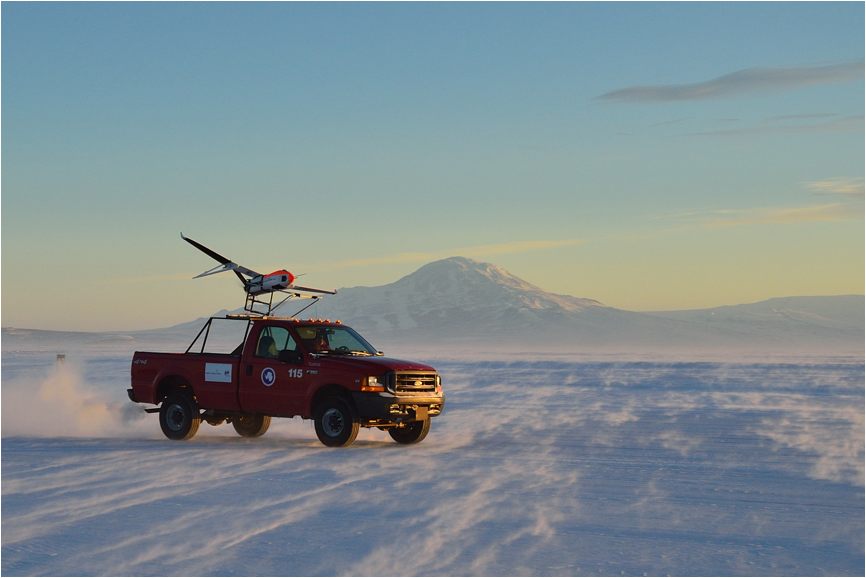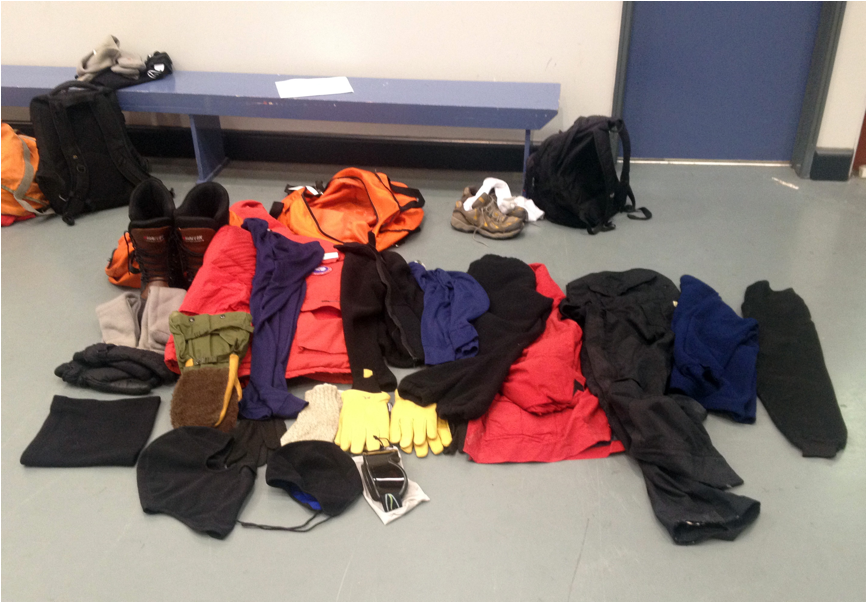To Antarctica – Again
6 January 2014
Once again I am on my way to Antarctica to study the weather of the southernmost continent. This trip is my 12th to Antarctica. You can read about some of my previous trips at the following links:
August – October 2012
http://cires.colorado.edu/blogs/antarcticuavs/
January – February 2012
http://dl.dropboxusercontent.com/u/53700947/Antarctic_blog/index.html
August – October 2009
http://icestories.exploratorium.edu/dispatches/author/john-cassano/
I never get tired of going to Antarctica as there is always something new to see or do. On this trip my new experience will be camping for two weeks at a small (just 3 to 4 of us), remote (100 miles from the main US base at McMurdo station) field camp at the Tall Tower automatic weather station (AWS).
 Map of northwestern corner of the Ross Ice Shelf showing McMurdo Station and several automatic weather stations.
Map of northwestern corner of the Ross Ice Shelf showing McMurdo Station and several automatic weather stations.
This will be my first time at a small self-supported camp as opposed to a camp run by the US Antarctic Program (USAP) support contractor. We will get to this camp by snowmobile rather than flying there on a ski-equipped plane or helicopter. We will follow a snow road that runs from McMurdo to the South Pole that is used by the USAP to haul gear and fuel to the South Pole. This “road” crosses the large (as big as France), flat, and featureless Ross Ice Shelf and crosses over a zone of crevasses known as the shear zone where the floating ice of the ice shelf slides past the mountains and islands located in the northwest corner of the ice shelf.
 An example of the Ross Ice Shelf scenery we’ll be looking at for two weeks in mid-January, except where we will be camping is further from the mountains so we won’t see even a hint of mountains on the horizon as in this picture.
An example of the Ross Ice Shelf scenery we’ll be looking at for two weeks in mid-January, except where we will be camping is further from the mountains so we won’t see even a hint of mountains on the horizon as in this picture.
What will we be doing at this camp? We will be flying unmanned aerial vehicles (UAVs or drones) to make measurements of the atmosphere. Over the last several years my research group has led the push to use UAVs to study the Antarctic atmosphere. We made the first winter flights with UAVs in the Antarctic in September 2009 (remember winter in the Southern hemisphere is opposite that in Northern Hemisphere) and have made several additional trips since then to measure the atmosphere with UAVs.
 Launching an Aerosonde UAV from the Pegasus Ice Runway in September 2012.
Launching an Aerosonde UAV from the Pegasus Ice Runway in September 2012.
On this trip we will spend two weeks flying UAVs at the remote Tall Tower AWS (named because it is nearly 100 feet tall compared to the normal 9 feet tall for most of our AWS).
 Tall Tower AWS and Twin Otter aircraft.
Tall Tower AWS and Twin Otter aircraft.
This tall AWS was installed several years ago to allow us to study the vertical structure of the atmosphere. Our UAV observations will allow us to make measurements above the top of this tower and to fully observe the lowest part of the atmosphere known as the boundary layer, which can extend several thousand feet above the ground. The boundary layer is the part of the atmosphere that directly “feels” the influence of the underlying surface. As such it is important for linking atmosphere and surface processes, and of course the boundary layer is the part of the atmosphere where we all live.
Joining me at this field camp will be Melissa, a post-doc in my research group, Ben, a graduate student from the University of Canterbury in Christchurch, New Zealand, and a mountaineer from the USAP. Our camp will consist of several tents – one for each of us to sleep in and another larger tent for cooking and working – and not much else. Our main job while at this camp will be to do frequent UAV flights to observe how the boundary layer changes over time. Previous UAV measurements we have made have shown that the boundary layer changes very quickly – sometimes with large changes in just a few minutes. The UAVs we will be using allow us to observe the boundary layer every 15 minutes and provides us with a level of detail on how the boundary layer changes with time that is hard to get from any other meteorological instruments.
I’m scheduled to fly to McMurdo from Christchurch, New Zealand tomorrow (Tuesday 7 January). Originally I was scheduled to fly south on Friday 3 January but my laptop decided that after 6 years of traveling the world with me it had finally had enough and began to die. Since I am counting on having my laptop to analyze the data we collect while in the field the loss of my laptop was a serious problem. I spent several extra days in New Zealand buying and setting up a new laptop and am now ready to head south.
Melissa flew to Antarctica on Saturday 4 January – her original flight on 3 January was delayed one day. She is starting to get everything prepared for our field camp. Our plan, which is always subject to change in the Antarctic, is to snowmobile to our Tall Tower camp next Monday (13 January) and spend two weeks at this camp. We will return to New Zealand in early February.
I arrived in New Zealand on 29 December and had a few free days before getting to the work part of this trip. I took advantage of the free time to do a short bike tour from Arthur’s Pass National Park, high in the Southern Alps, back to Christchurch.
 Sheep farms and the Southern Alps along the Rakaia River valley. I rode into strong norwester headwinds (similar to a chinook in Colorado or a foehn in the European Alps) on this part of my bike tour but the stunning scenery more than made up for the extra effort required to ride uphill into a headwind.
Sheep farms and the Southern Alps along the Rakaia River valley. I rode into strong norwester headwinds (similar to a chinook in Colorado or a foehn in the European Alps) on this part of my bike tour but the stunning scenery more than made up for the extra effort required to ride uphill into a headwind.
I returned to Christchurch on 1 January and met up with Melissa and Dave (from the University of Wisconsin Antarctic AWS project) who had just flown down to New Zealand from the US. We were all issued our extreme cold weather (ECW) gear on 2 January. The cold weather gear we are issued includes polypropolene base layers (long underwear and tops), fleece pants and jackets, a windproof jacket, a heavy parka, tremendous insulated boots, and a wide range of hats, gloves, socks, face masks, and goggles. This is supplemented with some additional cold weather gear that each of us brought down.
 Extreme cold weather gear provided by the US Antarctic Program.
Extreme cold weather gear provided by the US Antarctic Program.
This gear combined with all of my regular clothes, items for work, and a stash of candy bars as a treat for when I’m at the Tall Tower field camp means I am not traveling light. We are allowed a total of 150 pounds of checked luggage for the flight to Antarctica and this doesn’t include the two large shipping crates of scientific gear I sent to Antarctica back in September.
Since 2 January I’ve been busy buying and setting up my new laptop (a very small and fast MacBook Air) and have also been enjoying the perfect summer weather of New Zealand. I’ve done a bit of bike riding around Christchurch – out to the beaches and along the Port Hills – and have also spent time in the Christchurch botanic gardens. These gardens are one of my favorite places anywhere – they are a peaceful and beautiful spot perfect for walking or sitting on quiet summer evenings.
 The Christchurch botanic gardens – I won’t be seeing any colors this vibrant once I get to Antarctica.
The Christchurch botanic gardens – I won’t be seeing any colors this vibrant once I get to Antarctica.
I’m scheduled to fly to Antarctica tomorrow morning at 9AM and should arrive in McMurdo in time for dinner. Hopefully my next blog post will be from Antarctica.
Thanks for reading.
John
